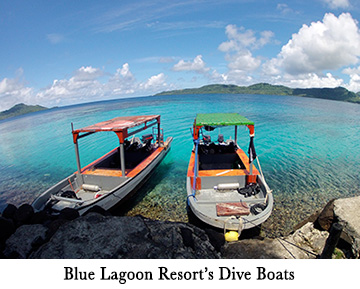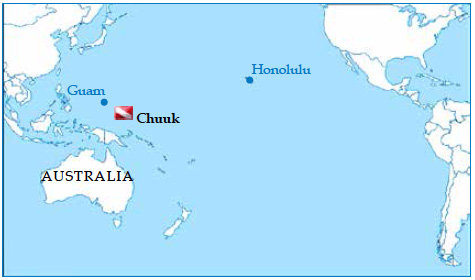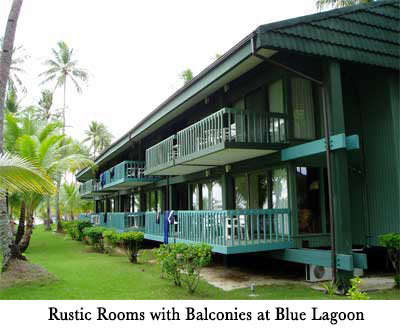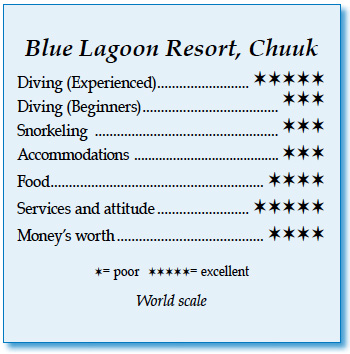Blue Lagoon Resort, ChuukContents of this Issue: Serious BC Issues: A Mares Recall, and a Major Design Flaw Red Tide Is Gone, But Here Is Florida’s New Coastal Threat Splash Inn Dive Resort, Roatan Send Your Reader Reports (And Tell Us About Plastic Use) Why You Had Better Confirm Your Flight Itinerary Technical Diving: Is It For You? The “Canaries of the Reef” Are in Trouble Sidemount Diving: Take that Weight off Your Back Lessons from My Wife’s Snorkeling Death Maybe This Is the Reason Why His Wife Drowned Old Dive Computers, Odd Treatment: Letters to the Editor A Catastrophic Regulator Failure Editorial Office: Ben Davison Publisher and Editor Undercurrent 3020 Bridgeway, Suite 102 Sausalito, CA 94965 a set-your-own-pace schedule on Truk Lagoon’s wreck dives from the April, 2019 issue of Undercurrent
Dear Fellow Diver: On February 17, 1944, the United States bombed the hell out of Truk Lagoon with "Operation Hailstone," an aerial attack on the Japanese planes and ships sheltered there. That included dropping six 500-pound bombs onto the San Francisco Maru, one of the 40-something Japanese cargo ships now resting in the lagoon. Seventy-five years later, I thought about that morning attack as I swam through her aft holds and saw what remained -- probably more divers have been through her holds now than WWII soldiers. I plunged down 180 feet into hold four to find a big, squat pile of munitions, including rows of depth charges. In the next hold over were torpedoes, many that broke when the ship went down. Up at 165 feet, I swam past the burned-out wheelhouse and a trio of three-man tanks sitting on the deck, gun barrels intact. Down in hold two were a water tanker and pickup truck, but beneath those was the money shot -- the floor was littered with beach mines. Stacks upon stacks of the globe-shaped explosives were everywhere.
If you're into wreck diving, Truk Lagoon is heaven. The WWII wrecks are scattered within a few miles of each other, all in a calm atoll with no currents, and many of them are within recreational depths -- albeit they're best for divers with lots of 100- foot dives under their belts. I treated these as technical dives, yet all but one wreck I did is possible to do with either air or nitrox from a single tank (see the feature, "Technical Diving: Is It for You?"). What's the best way to experience them -- by land or by sea? I've done both before, but I had 10 days in December to devote to Truk Lagoon, so I decided to revisit both options and see if I had a clear favorite. I enjoyed staying on the palm-tree-studded island of Chuuk (ronounced "chook," that's the official name for this Micronesian state; according to Undercurrent editor John Bantin, the Japanese had difficulty pronouncing that, so called the area Truk) and taking boats from the dock to the wrecks. Then again, Truk Odyssey, which I took the following week (and review in next month's Undercurrent) let me hop off the deck to dive wrecks up to five times a day. Getting to Chuuk is not easy; United is the only airline servicing the island. I took a seven-hour flight to Honolulu and stayed overnight, then did the same in Guam, followed by a two-hour morning flight to Chuuk. So I arrived with a good dose of jet lag at Blue Lagoon Dive Resort -- while its van picked us up promptly at the airport, the four-mile ride down the potholed road was headache-inducing. The resort, with lush emerald grounds and hundreds of tall palm trees, is as well-manicured as Disneyland. I was greeted by a friendly man at the front desk, and after a quick check-in, he waved over a couple of sturdy staffers to lug my gear bags up to a second-floor room in one of the squat wooden buildings scattered around the property. Loud-patterned bedspread aside, the queen bed was soft and inviting. Dated furnishings, but the full tiled bath was clean, the hot showers and cold air conditioning abundant, and my green-painted balcony had a table and two chairs to enjoy gorgeous views of the water and spectacular sunsets. One advantage of land-based diving is surface-interval activities -- Blue Lagoon offers snorkeling, picnic lunches on an island, and WWII relic tours. But I was here for the wrecks -- I had emailed my diving preferences several months in advance -- so I walked 500 yards to the dockside dive shop, painted a cheerful blue and packed with dive merchandise for sale and rent, to check in. Sam, my favorite dive guide, was waiting for me. A Chuuk native I had met on my first trip here, Sam knows the wrecks inside and out, and besides having great diving skills, he is as cheerful as the sun overhead -- I never saw the smile drop from his face. Sam set no schedules or itinerary for us -- he, my buddy and I just talked about what we wanted to do and boom, we were off. Without a set time to leave the dock, I never felt rushed.
We spent the hour-long surface intervals either snorkeling shallow sites or on Eten Island, once a busy airfield, drinking fresh coconut milk. (For a cash "donation," Eten locals gave us punctured coconuts.) On the day we had a snorkeler aboard, Sam moored on the Gosei Maru, sunk by an "Operation Hailstorm" torpedo and now resting on a slope, with her stern at eight feet and her bow below 100 feet. The clear water around the propeller, home to schooling snappers and bright anemones, made an exceptional place to relax while offgassing. After two dives, the boats headed back to the dive shop. I had signed up for afternoon dives but didn't have to get out of my wet gear and trudge to the dining room for lunch, because the restaurant had prepared box lunches for those who ordered the evening before. Eating my PBJ and banana sandwich, chips and fruit with a bottle of water or soda while stretched out in the shade and regarding the water was bliss, especially knowing there was no rush -- Sam and our captain would be ready to head back out when my buddy and I were. On two days, we were the only ones on our boat for the third dive. And with so many sites in the lagoon being dived by small boats with just a few guests, we often were the only divers on a huge wreck. Because I was diving sidemount, I could use my same tanks each day, saving me the time of re-rigging them, and the dive shop had plenty of outdoor wetsuit hanging space and lockable storage rooms for stashing my wet gear. For trained technical divers, Blue Lagoon supports rebreathers; it rents backmounted doubles and deco bottles, and can supply trimix and oxygen.
But that dive reminded me of Undercurrent's recent writeup about the man who took his children diving in Truk Lagoon. This is not a place for children, or novices, for that matter. With calm seas, no currents, and clear, warm water, the diving seems deceptively easy, but given the depths of most wrecks, sport divers breathing air like this teenaged diver use their allotted time in a hurry. In my opinion, Truk-bound divers should have a minimum of 50 dives after receiving their Advanced Openwater certification, with a good deal of those being between 80 and 130 feet. Diving always works up an appetite, and Blue Lagoon's restaurant, with padded rattan chairs and floor-to-ceiling windows offering awesome water views, kept me filled with basic but tasty servings. Breakfast was American-style eggs, fruit, toast and pancakes, with sides of bacon, sausage, potatoes or fried rice. Meals, prepared as ordered, came in large portions -- when I couldn't finish my three huge banana pancakes the first morning, I decided the next day to split a plate with my partner. Lunch and dinner options ranged from cheeseburgers and club sandwiches to steaks, salads and stir-fries -- my favorite meal was the Monte Cristo sandwich with French fries and a banana split for dessert. The friendly wait staff was slow, but it was hard to get mad when they forgot something, because they always took care of it with a smile. All menu items are a la carte, but without drinks, my buddy and I never spent more than $20 on a meal for the two of us, including the banana splits. Sometimes after dinner we then waddled over to the Sunset Bar, which opens every evening with Happy Hour specials.
While I dived with Americans and Canadians, over half the divers at Blue Lagoon were Asian, and most were male, but ages ranged from the 13-year-old junior openwater diver to 60-ish. The lagoon doesn't offer many shallow dives suitable for beginning divers. The Betty Bomber, sitting at 60 feet, is a popular one, but I found the Emily "Flying Boat" more interesting. This four-engine float plane crashed in the water, landing upside-down on the 50-foot bottom, and she sports a fair amount of colorful soft coral growth and life. I found a couple of messmate pipefish and tiny sap-sucking sea slugs, while my buddy spotted an upside-down jellyfish and played hide and seek with a brown coral blenny. After leaving the wreckage, I finned over to a small reef that was home to Moorish idols, bannerfish and rabbitfish. After a three-night stay and eight fantastic dives, it was time to board the Truk Odyssey, which had tied up to the dock next door. For me, the real upside of Blue Lagoon was picking the wrecks I wanted to dive and leaving at a time my buddy and I chose. There are disadvantages: the rooms need a facelift, the boats aren't the most comfortable, I had to take my gear apart and reassemble it every day, and the half-hour rides from dive shop to dive sites and back meant there weren't as many dive opportunities per day. But I enjoyed the quiet downtime after my dives, and what's better than drinking fresh coconut milk straight while offgassing from a dive through a WWII warship? Next issue, I'll tell you about traveling Truk Lagoon by liveaboard. -- L.E.D. Our Undercover Diver's Bio: "I got certified to dive in Florida in 1998 and received my instructor credentials in 2000. I've done 1,200 dives in seven mainland U.S. states, more than 20 Caribbean islands, British Columbia, Hawaii, Micronesia and in Mexico's stunning cenotes. I enjoy researching new places to dive, and have been my own travel agent for the past decade."
|

I want to get all the stories! Tell me how I can become an Undercurrent Online Member and get online access to all the articles of Undercurrent as well as thousands of first hand reports on dive operations world-wide
| Home | Online Members Area | My Account |
Login
|
Join
|
| Travel Index |
Dive Resort & Liveaboard Reviews
|
Featured Reports
|
Recent
Issues
|
Back Issues
|
|
Dive Gear
Index
|
Health/Safety Index
|
Environment & Misc.
Index
|
Seasonal Planner
|
Blogs
|
Free Articles
|
Book Picks
|
News
|
|
Special Offers
|
RSS
|
FAQ
|
About Us
|
Contact Us
|
Links
|
3020 Bridgeway, Ste 102, Sausalito, Ca 94965
All rights reserved.

 I got a good look at the large bow gun on the bow, but
that was all I could do in 25 minutes. Dive time is limited
at that depth, so I had to start my long trip back to the
surface, which
included 30 minutes
of decompression.
When
I was here five
years ago, I had
to turn around
halfway -- my
narcosis made
me too nervous
to go on. But
after getting
into technical
diving so
I could explore
deeper wrecks,
I did this dive
on trimix, so my head was clear and I could take
away some good memories.
I got a good look at the large bow gun on the bow, but
that was all I could do in 25 minutes. Dive time is limited
at that depth, so I had to start my long trip back to the
surface, which
included 30 minutes
of decompression.
When
I was here five
years ago, I had
to turn around
halfway -- my
narcosis made
me too nervous
to go on. But
after getting
into technical
diving so
I could explore
deeper wrecks,
I did this dive
on trimix, so my head was clear and I could take
away some good memories. Another advantage: With at least 10 small, covered boats, Blue Lagoon can easily
group guests with different skill and interest levels, from novices to tech divers and
photographers. The seat-less wooden boats, each with two 40-HP outboard motors, have room
for up to six divers to sit on the unpadded, extra-wide gunwales. Some of those 30- to
40-minute rides were hard on my tailbone. The winds picked up on the day we dove the Rio
de Janeiro Maru, making the ride not only long but also bumpy and wet. By the time we
arrived, it looked like I had already been diving. Luckily, the water temperatures average
84 degrees. The wreck, resting on her starboard side at 94 feet, is great for sport
divers. After finning through dark, silty passageways, Sam showed us a hold full of beer
bottles and bolt-action rifles hidden away, then took us into another hold where huge
gun turrets were stored. There was a lot to see on the way up in the 80-foot visibility, including the huge prop, rudder and stern gun. At 40 feet, the port side, now facing
upward, was covered in small coral heads, each its own mini-ecosystem with a variety of
small fish. Diving with an 80-cubic-foot aluminum tank and 30-percent nitrox, I spent 50
minutes on this fascinating wreck.
Another advantage: With at least 10 small, covered boats, Blue Lagoon can easily
group guests with different skill and interest levels, from novices to tech divers and
photographers. The seat-less wooden boats, each with two 40-HP outboard motors, have room
for up to six divers to sit on the unpadded, extra-wide gunwales. Some of those 30- to
40-minute rides were hard on my tailbone. The winds picked up on the day we dove the Rio
de Janeiro Maru, making the ride not only long but also bumpy and wet. By the time we
arrived, it looked like I had already been diving. Luckily, the water temperatures average
84 degrees. The wreck, resting on her starboard side at 94 feet, is great for sport
divers. After finning through dark, silty passageways, Sam showed us a hold full of beer
bottles and bolt-action rifles hidden away, then took us into another hold where huge
gun turrets were stored. There was a lot to see on the way up in the 80-foot visibility, including the huge prop, rudder and stern gun. At 40 feet, the port side, now facing
upward, was covered in small coral heads, each its own mini-ecosystem with a variety of
small fish. Diving with an 80-cubic-foot aluminum tank and 30-percent nitrox, I spent 50
minutes on this fascinating wreck. I was a bit surprised one day to see
a mom and her two teenaged kids on our
boat for a morning dive. Another guide
came along to dive with the 13-year old
daughter, a junior openwater diver who was
not allowed to dive the Fujikawa Maru at
110 feet. That's one of the Lagoon's most
iconic sites, with its holds full of airplanes
and the infamous R2-D2-looking air
compressor in the machine shop. Sam led us
over the anemone-covered starboard rail to
the impressive bow with its large gun and
photogenic telegraph. The teenaged boy was
so excited to be diving his first wreck,
he was in constant motion, swimming quickly
from artifact to artifact. By the time we had swum through the torpedo hole in the hull
into the hold, he was out of air and had to finish his dive breathing from Sam's spare
tank. I silently thanked Sam for allowing us all to keep diving, because the Zero fighters
stored in this hold were not to be missed. I could read the tail number on one plane
and swim into the fuselage of another. Spare props, fuel tanks and landing gear, along
with gas masks and barrels, were scattered all over the floor.
I was a bit surprised one day to see
a mom and her two teenaged kids on our
boat for a morning dive. Another guide
came along to dive with the 13-year old
daughter, a junior openwater diver who was
not allowed to dive the Fujikawa Maru at
110 feet. That's one of the Lagoon's most
iconic sites, with its holds full of airplanes
and the infamous R2-D2-looking air
compressor in the machine shop. Sam led us
over the anemone-covered starboard rail to
the impressive bow with its large gun and
photogenic telegraph. The teenaged boy was
so excited to be diving his first wreck,
he was in constant motion, swimming quickly
from artifact to artifact. By the time we had swum through the torpedo hole in the hull
into the hold, he was out of air and had to finish his dive breathing from Sam's spare
tank. I silently thanked Sam for allowing us all to keep diving, because the Zero fighters
stored in this hold were not to be missed. I could read the tail number on one plane
and swim into the fuselage of another. Spare props, fuel tanks and landing gear, along
with gas masks and barrels, were scattered all over the floor. Even though Sam took care of most of my
needs, other guides from the all-male dive
staff helped me find an analyzer or carried my
tanks. It amazed me every time we pulled onto a
wreck -- there were no buoys on the surface --
the captain and guide knew the exact locations
of the ships. Sam jumped in and tied off to a
submerged buoy, the captain helped me attach my
sidemounted tanks, then I entered the water by
backroll. Most divers handed up their weights,
then removed their BCs before climbing aboard
on the small ladder; I disconnected my tanks and handed them up as well. As I took my seat on the gunwale, I was handed a cup of cold
water, refreshing during those 85-degree days.
Even though Sam took care of most of my
needs, other guides from the all-male dive
staff helped me find an analyzer or carried my
tanks. It amazed me every time we pulled onto a
wreck -- there were no buoys on the surface --
the captain and guide knew the exact locations
of the ships. Sam jumped in and tied off to a
submerged buoy, the captain helped me attach my
sidemounted tanks, then I entered the water by
backroll. Most divers handed up their weights,
then removed their BCs before climbing aboard
on the small ladder; I disconnected my tanks and handed them up as well. As I took my seat on the gunwale, I was handed a cup of cold
water, refreshing during those 85-degree days. Divers Compass: My Superior Room at Blue Lagoon was $145 per night,
plus a five-percent room tax; everything there is priced separately, so
meals, drinks, dives and transfers are all extra . . . I paid $110 for
a two-tank dive and $30 for a third dive; nitrox fills were $8 each for
30 percent . . . my Honolulu overnight at the Best Western Plaza Hotel,
with free airport shuttle, was $200; my Guam overnight at the Fiesta
Resort was $150 and the airport shuttle was $12 . . . Chuuk electricity
and currency are the same as in the U.S., and English is spoken; paying
with cash is cheaper, but credit cards are accepted for an additional 3.5
percent . . . Website:
Divers Compass: My Superior Room at Blue Lagoon was $145 per night,
plus a five-percent room tax; everything there is priced separately, so
meals, drinks, dives and transfers are all extra . . . I paid $110 for
a two-tank dive and $30 for a third dive; nitrox fills were $8 each for
30 percent . . . my Honolulu overnight at the Best Western Plaza Hotel,
with free airport shuttle, was $200; my Guam overnight at the Fiesta
Resort was $150 and the airport shuttle was $12 . . . Chuuk electricity
and currency are the same as in the U.S., and English is spoken; paying
with cash is cheaper, but credit cards are accepted for an additional 3.5
percent . . . Website: 